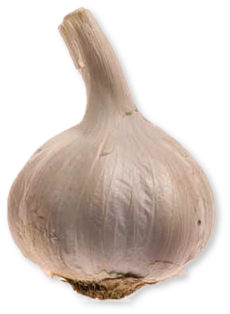Our Products
Allium sativum, Garlic
 |
The use of Garlic has a long history going back 7000 years, the earliest records of its use coming from Ancient Egypt. From there it's use is usually said to have spread to China via India, although some historians claim that it originated in China. As it's actually native to Central Asia we might conclude that it's history will always be obscure, no doubt it was well appreciated before it was ever written about,
China is now by far the world's largest producer of Garlic, being responsible for about two thirds of the total world production. It's grown throughout the temperate areas of the world, with different cultivars being selected to match the local conditions.
Garlic has been used medicinally throughout it's history, The Ancient Egyptians, according to the Greek historian Heroditus, fed it to the slaves who they used to build their pyramids. They believed not only that it would increase their strength, allowing them to do more work, but also that it would decrease their appetite and hence their need for food.
 |
The Greeks were impressed enough by such reports that the original Olympic athletes fed on it to increase their performance. Whether it actually gave them an advantage is not recorded, but it does show that performance enhancing drugs are by no means a modern invention.
By Roman times we hear that Garlic is a good prevention against snakebite. The strong taste and smell of Garlic is assumed to have evolved as a deterent against being eaten, and likely it is responsible for widespread beliefs that it can be used as a protection, particularly against insect bites and disease. Of course the best known use for Garlic as deterent in literature is to keep away vampires. Eating garlic will produce chemicals that not only create the well known 'garlic breath', but also end up in the blood so perhaps our vampire would indeed be tempted to try elsewhere.
Meanwhile the Chinese used Garlic for stomach aches and diarrhea while the Indian Ayurvedic Medicine system recommends it for 'blood cleansing'.
These days we see some evidence that Garlic can lower cholesterol, reduce high blood pressure and even be effective against certain cancers. However it isn't recommended to substitute it for prescription medicines.
 |
The long history of Garlic as a cure-all is notable in it's inconsistancy, however nutritionally it does have its good points, being rich in vitamin B6 (pyridoxine) manganese, selenium and vitamin C. Also consider one very concrete benefit, the tastyness of Garlic is very useful in giving flavour to foods with low salt, and of course salt reduction has well proven health benefits.
Where Garlic really come into its own is in cooking. While technically it's neither herb nor spice, being classified as a vegetable its flavour is essential to a great many dishes from eastern Asia, South Asia, Southeast Asia, the Middle East, northern Africa, southern Europe, and parts of South and Central America. Typically Garlic cloves will be peeled and finely sliced or crushed before being added at the begining of cooking. Garlic blends particularly well with onion, tomato and ginger.
To add the essential flavour of Garlic to a commercial product it's effective to use a dryed product, at Camstar we can provide dried garlic in a wide variety of formats from powdered to sliced, please don't hesitate to contact us.
Martin Hoxworth - Group Sales Manager: martin camstar.co.uk camstar.co.uk |
 |




 camstar.co.uk
camstar.co.uk